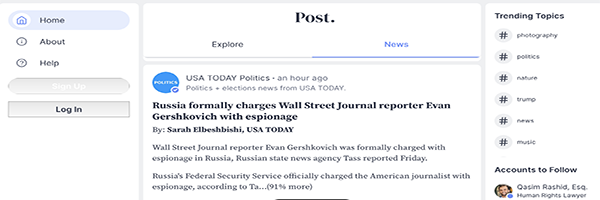 |
||||||||||||
|
||||||||||||
| A Social Media Site for People Who Want 100% News and 0% Toxicity |
 |
| "I believe the future newspaper is the feed and want to make it more civil for users, profitable for publishers, and better for society." — Noam Bardin, Post News Founder Every publisher wants readers to engage with other readers on their sites, and many even encourage direct relationships with journalists. Unfortunately, haters and trolls see readers' comment sections as the perfect vehicle to harass anyone they disagree with. Sometimes the journalists themselves are on the receiving end of toxic behavior. According to the International Center for Journalists (ICFJ), 20% of women journalists who are harassed online also experience real-world violence. The problem is so severe that ICFJ has created an online violence early warning system to identify key indicators and metrics signaling the escalation of online violence against women journalists. Post News, a social media site recently launched to the public, addresses that toxicity head-on. It invites users to "follow, share, support, and interact with diverse voices on topics you care about and join smart conversations without the toxicity." Civility is a key theme. Post News also takes a zero-tolerance approach to the complete range of bad behavior. Its content policy explicitly bans trolling and attempts to "own" anyone along with misinformation, disinformation, and fake news. Readers' Choice of Content But civility is just the start. The Post also seeks to be a platform for readers to gain exposure to more content and for independent journalists to find audiences. Post News describes itself as "a place for people to discover, read, watch, discuss and share premium news content without subscriptions or ads. Pay just for what you read (on a per article basis), and help keep independent journalism in business." Post News also helps writers and publishers monetize their content by allowing readers to purchase articles individually. This is similar to how the Brave browser allows users to tip authors and content creators with BAT (Basic Attention Token). On Post News, this works by inviting users to purchase points (300 points cost $4.20) and to apply those points to read articles across a spectrum of news sites that are typically behind a paywall. Some articles are free to read, and others cost 1 to 60 points. Freelance writers and independent journalists are encouraged to post their content on the site to build audiences for their work. Post News' registration process helps writers and readers with mutual interests find one another. Users are invited to select topics of interest and follow writers who focus on those topics. |
| What's interesting about Post News' model is that users can pay to read individual articles from various news sources rather than pay for multiple subscriptions. If, for instance, a friend sends an article from a site to which you don't have a subscription, you might be able to find and read it on The Post. Post News, therefore, is an opportunity for publishers to open a new revenue stream. Noam Bardin told TechCrunch that the average CPM for paid posts is $25, although CPMs can go much higher (at least one article had a $300 CPM). Free posts can receive donations and tips, which Bardin says averages $1.30 CPM. More importantly, Post News may be a way for publishers to find new paid subscribers. Let's say a user reads dozens of articles from a specific publisher each week, he or she may decide it's worth subscribing to that publication directly. Time will tell if Post News catches on and receives the kind of traffic that earns serious money for publishers and writers. According to Similarweb, The Post received 1.8M visits in January, with the average visitor spending 5 minutes on the site, viewing 4.3 pages. If Post News does succeed, however, it may be a way for publishers to monetize the types of news stories that tend to scare away advertisers but are of keen importance to audiences. |
| “Operation Cookie Monster”: FBI Seizes the Genesis Market, An Infamous Bot Market |
 |
| Any bad actor logging onto the Genesis Market this past Wednesday was in for a rude awakening. Upon entering the domain, users received a notice informing them that U.S. law enforcement officials executed a seizure warrant on the infamous bot market. The operation, coined “Operation Cookie Monster,” resulted in the arrest of 120 people and searches of 200 people globally. While the United States District Court for the Eastern District of Wisconsin issued the warrant nationally, law enforcement agencies from Europe, Australia, and Canada also issued arrest warrants. “This is the biggest operation of its kind. We’re not just going after administrators or taking sites down; we’re going after users on a global scale,” said a senior FBI Official. Launched in 2017, The Genesis Market is an invitation-only criminal forum offering stolen data from over 1.5 million computers worldwide containing login details for over 80 million user accounts. Victims of these bad actors have lost an estimated sum of more than $10 million. This past February, Genesis Market started recruiting more data sellers to keep up with the demands for stolen data. In addition to customer logins, the bot market was also able to create digital footprints for hacked consumers. As long as a bad actor can access the hacked computer, the consumer’s digital footprint is kept current. “In other words, Genesis customers aren’t making a one-time buy of stolen information of unknown vintage; they’re paying for a de facto subscription to the victim’s information, even if that information changes,” according to researchers at cybersecurity firm Sophos. |
| The Genesis Market is one of the largest bot markets worldwide, if not the largest. The seizure of their assets and the arrest of hundreds of people worldwide is a huge wake-up call for bad actors who steal data for sport. The announcement of the arrests is some much-needed good news for the advertising ecosystem, which these bad actors have plagued for years. The arrests could potentially hinder new hackers from joining the vast criminal syndicate. Of course, this could also mean bad actors become more sly with their tactics. They have innovated new ways to trick the system before. “One positively flourishing sector is the bot economy. And it’s not just growing in size; the level of sophistication of bot networks is increasing in leaps in bounds,” said Zach Edwards, Senior Manager of Threats Insight for HUMAN. “As a result, the bot economy is now a favored tool for sophisticated organized criminal activity. While these arrests highlight that the federal government is paying close attention to these bad actors, this does not mean they are going away. Publishers and consumers alike must protect themselves. For Consumers: ° Use antivirus software at all times. ° Also, consider employing the use of a password manager and file encryption tools to ensure that even if a criminal infects your device, there is little for them to steal. For Publishers: ° Every publisher who connects to programmatic is susceptible to a fraud or malvertising attack. ° To protect themselves and consumers, they must determine what parts of the supply chain are most vulnerable to cyber-attacks. This will allow publishers and advertisers to put better security measures in place. ° Failure to stop these attacks could result in the loss of consumer trust. |
| Publishers Q1 Revenue Results Higher than Predicted, but Not by Much |
 |
| Last year, most publishers were not optimistic about their Q1 revenue results. In January, the trends were as bleak as expected. Many publishers were 10-25% behind their ad forecasts for the quarter. "We're coming off a Q4 [2022] that was up 30% to 31% in direct [advertising revenue], which was epic. And I think whatever bug [our competitors] had in Q4 caught up with us in Q1. We're down right now by as much as 20% to 25% in our forecast for Q1," said an anonymous executive from a digital media company. As the tide turned at the end of the first quarter, publishers' results started to look up. Although revenue is down, the results are not as grim as expected. This syncs with what publishers told us about their Q1 revenue at AdMonsters' recent Publisher Forum in Miami. Here is how some publishers spoke about the results to Digiday, anonymously, of course: One publisher asserted that they ended the quarter down by a mid to high-single-digit percentage. Another publisher said that over the last three months, their ad spend results were higher than the previous three months. While it is not exactly where they want to be, it is a sign that they are moving in the right direction. A few publishers revealed that bubbling deals in March's last few weeks excite them more for their Q2 and Q3 results. Sean Griffey, CEO and co-founder of Industry Dive, and Orlando Reece, Head of Global Sales at Insider, espoused that deals materialized for them. Griffey says publishers can't use late-term contracts for Q1 revenue results. Once publishers execute the campaigns, they consider the metrics for the second or third quarters. While there is some good news, publishers are cautious about taking on the glass-half-full mentality. "We're still going up, but it's more effort to do so," said an anonymous publisher. "Overall, it will be a rough three or four quarters. It's so variable. Things seem OK, and then there's the bank collapse. So many of these macroeconomic things keep knocking you off. It doesn't feel existential, but it certainly feels hard. And it certainly feels that we're tight." |
| The ad spend slowdown is in full effect, but metrics are less bleak than publishers first thought at the end of last year. Dentsu's biannual Global Ad Spend Forecast predicted that global advertising spending would grow by 3.8%, reaching $740.9 billion this year. Magna's Q1 results show that the industry finished below that threshold. They believe that year-end growth will be 3.4% to $326 billion. But there is still some wiggle room for the metrics to increase. Vincent Létang, EVP of Global Market Intelligence at Magna, attributes the small but sudden growth to the rise of streaming, ad-supported video, and rising investment in consumer-facing businesses, which offers advertisers a medium to reach consumers using retail media data. "If it were 20 years ago, in [this] economic climate, we would probably expect advertising spending to fall, but we don't…because there are organic growth factors to put against this macroeconomic environment that is uncertain indeed," he said. "The organic drivers that boosted the ad market in 2021 and the first half of 2022 are still around and mitigating the impact of stressful economic signals." Other industry experts attributed the slight rise in Q1 results to the massive layoffs across all industries. Based on data collected by Finbold, the global tech industry recorded 166,004 layoffs in Q1. January accounted for the highest percentage of dismissals, an estimated 53%. While some see the tech layoffs as a sign of instability for the industry, and it certainly is, others believe that some of the small revenue growth is due to the layoffs. There have been major criticisms of companies participating in these mass firings — most critics accused companies of firing employees based on herd mentality or of retaliating against employees asking for better salaries. Does that release of the burden from paying over 100,000 salaries alleviate some of these brands' revenue concerns? |
| Around the Water Cooler |
 |
#ICYMI Ad Tech Firms Called Out For IP Theft While not a new practice, publishers are tired of ad tech firms' ad scraping tactics. The method involves scraping data from publishers' websites and packaging that data into contextual segments which advertisers can use to target users. (AdWeek) Italy Bans ChatGPT Based on Privacy Concerns At the end of March, Italy's data regulator temporarily banned ChatGPT because they accused them of using consumers' personal information for training data. In response, ChatGPT restricted the tech in the country to address the regulators' concerns. (Wired) Alcohol Recovery Startup Poured Up Users Data to Advertisers The California attorney general filed a data breach notification after they caught alcohol recovery startups, Monument and Tempest, sharing users' personal and health information with advertisers. Monument CEO Mike Russell confirmed that more than 100,000 patients are affected. (Tech Crunch) ChatGPT Plugins Expands Generative AI into Commerce Is ChatGPT on its way to becoming the next big app store? OpenAI announced the integration of plugins that allow brands a way to build inside ChatGPT. For example, users can use the travel company Kayak's plugin to ask ChatGPT to book a flight, and the tech will integrate data from Kayak's website to book it for them. (AdAge) |








